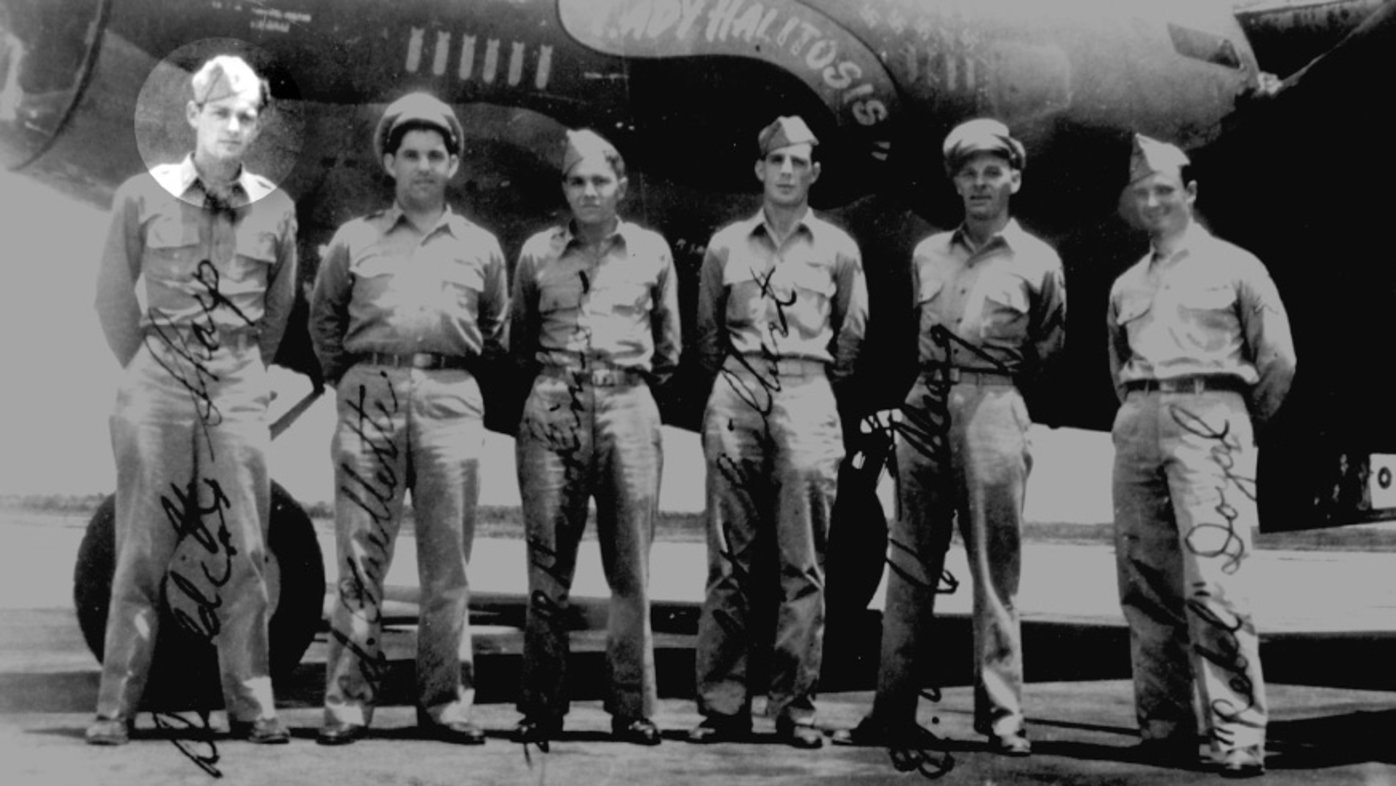
How to recognize the signs of breast cancer
Regular mammograms are vital. But you can be your own best health advocate by also knowing the signs of breast cancer and taking action when needed.

Lt. Donald N. Sharp (left) and the crew of the “Lady Halitosis.” Sharp and his navigator, Lt. William Hawkinson (third from left), went down with their B-26 on December 23, 1944, after securing the safety of their crew.
Patients and their loved ones often glance at the painting of a young World War II serviceman in the lobby of Sharp Memorial Hospital. Few know his story and how his legacy would touch their lives as it has countless others through the years.
On the morning of Dec. 23, 1944, a group of 32 heavily laden B-26 Marauders, American twin-engine combat aircraft, left the Roye-Amy Airfield in France. Their mission was to destroy a railway bridge deep in German territory. Just half the planes and their crews returned.
Little has been written about the costly battle fought that day, but it was one that was marked by courage and a selfless devotion to duty. Nearly 6,000 miles away and seven decades later, the legacy of Mission 203 echoes throughout San Diego.
Among those who gave their life that day for their country was Lt. Donald N. Sharp, a 22-year-old bomber pilot destined by fate to be the namesake of Sharp Memorial Hospital and Sharp HealthCare.
Hometown hero
Donald N. Sharp was born in San Diego on Sept. 9, 1922. He was a resident of Coronado from birth until 1937. He attended elementary and junior high schools on the island and from there, went to Lawrenceville, New Jersey, and then Claremont, California, before entering Stanford University in 1941. Early in 1942, shortly after the attack on Pearl Harbor, he enlisted in the United States Army Air Corps, now known as the Army Air Force.
After a routine takeoff and once above the dense overcast sky, the planes piloted by Donald and the others drew together, creating a close formation that would provide the force with maximum protection should the Luftwaffe, the German Air Force, challenge this further encroachment over its territory.
Thus far, the mission had been uneventful. But that would soon change. The formation was scheduled to meet its fighter escort at 11:30 am, but there was no sign of the P-47 fighter aircraft at the rendezvous. Just before noon, a force of 60 enemy fighters tore into the Marauders. First collectively, then in pairs and in threes, they carried out their attacks from every angle.
As the formation suffered heavy losses, the B-26G flown by Lt. Sharp felt the full weight of the enemy fighters’ cannon and machine gun attacks. With his plane’s right wing ablaze from a hit on the engine, and the hydraulic systems shot out, Lt. Sharp ordered his crew to bail out. Crewmen parachuted from the rear of the burning plane while the selfless Lt. Sharp remained at the controls and died alongside his navigator, Lt. William Hawkinson of Quincy, Illinois, as the plane plunged into the ground.
Of the 32 aircraft dispatched on that mission, only 16 returned. Almost all were damaged. For its determination and courage during the course of Mission 203 over the skies of Germany, Lt. Sharp’s 391st Bomb Group received a Distinguished Unit Citation, later known as a Presidential Unit Citation, as acknowledgement of the great sacrifice made by those brave young men who faced daunting odds.
Leaving a legacy
The San Diego to which Lt. Sharp did not return was a much different place after World War II. Its population had grown to more than 300,000 with more people on the way, a large number who were veterans who had passed through during the war years. By 1946, it was evident that a new hospital would be needed for the growing community.
Donald’s death left a void in the life of his father, local rancher and radio station owner Thomas E. Sharp. As he sought out suitable ways to carry on his son’s name, a close friend, James Forward of the Union Title and Trust Company, suggested assisting with the development of a new hospital planned for San Diego. In 1950, Thomas E. Sharp gave $500,000 to the San Diego Hospital Association, with the commitment that a new hospital be named Donald N. Sharp Memorial Community Hospital and dedicated to all who sacrificed their lives. His only stipulation was that a portrait of his beloved son in uniform hang in the hospital’s lobby for all time.
The Donald N. Sharp Memorial Community Hospital was dedicated on April 2, 1955, and was widely praised as a symbol of medical achievement and united community effort. In a symbolic gesture, the key to the hospital was thrown away, so that “the doors of Sharp would never be closed again.”
Through the tragic loss of a heroic 22-year-old pilot on a cold December day half a world away and the dedication of a concerned community, the Sharp name lives on in an institution committed to fulfilling its mission of improving the health and well-being of the residents of San Diego.
Bill Littlejohn is CEO and senior vice president of the Sharp HealthCare Foundation. This essay is excerpted from “A San Diego Story,” written by Littlejohn to commemorate Sharp Memorial Hospital’s 50th anniversary in 2005.
Our weekly email brings you the latest health tips, recipes and stories.